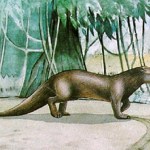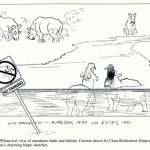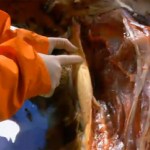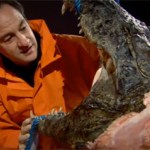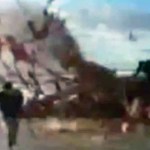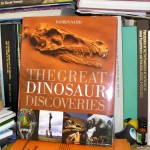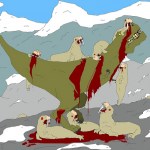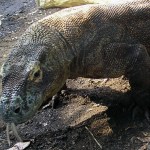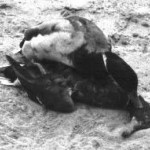
We now move to another mesonychian group: Hapalodectidae. This is yet another of those obscure little groups that sounds really interesting, yet are never the subject of focus or discussion. Virtually all of the literature on them - and that's still only ten papers or so - mentions the idea that they might have been piscivorous, but I can't find any elaboration of this and would like to see some. Hapalodectidae was named by Szalay & Gould (1966) as a mesonychid 'subfamily' (following Ting & Li (1987) and others, I here refer to the group as Hapalodectidae instead of Hapalodectinae);…
After Andrewsarchus, the best known mesonychians are the mesonychids... and, as we saw previously, Andrewsarchus may not be a mesonychian anyway. Mesonychids are a mostly Eocene group that originated in the Paleocene; Mesonyx, from the Middle Eocene of North America, was the first member of the group to be named (Cope published the name in 1872), and it's still one of the most familiar mesonychians, by which I mean one of the kinds featured most frequently in the popular and semi-technical literature. Its limbs indicate a cursorial lifestyle [Charles Knight's Mesonyx shown below].
A number…
We saw in the previous article that Andrewsarchus, most 'famous' of mesonychians (even though it may well not be a member of this group), is not just a scaled-up Eocene wolf, but really something quite unusual. Indeed, it's so unusual that Szalay & Gould (1966) decided that it's worthy of its own group, Andrewsarchinae. In modern phylogenetic parlance, Andrewsarchinae is redundant, given that it's monotypic. However... here's where things become a bit more complicated...
There's more than one species of Andrewsarchus, and what of Paratriisodon?
In 1959, Chow described the new species…
The previous article was a brief, cursory introduction to the mesonychians. Time to look at things in a bit more detail...
Andrewsarchus mongoliensis is, of course, 'the' mesonychian for most people, and one might get the impression that it's a typical member of the group. In fact it's most definitely not typical, and - ironically - it's not even part of Mesonychia in the majority of recent phylogenetic studies (O'Leary 1999, O'Leary & Geisler 1999, Gatesy & O'Leary 2001, Geisler 2001, O'Leary et al. 2003, O'Leary & Gatesy 2008)... though this might be due to the fact that it's…
What the hell, I've decided to keep the ball rolling with the Paleogene mammals, and do a whole week series on mesonychians. Yes, let's deal with a group that everyone has at least heard of.
Mesonychians are an assemblage of Paleocene and Eocene mammals, best characterized (or are they?) by the superficially wolf-like carnivorous or omnivorous forms Andrewsarchus and Mesonyx [life-sized Andrewsarchus model above from here]. Why use the term 'mesonychians' and not 'mesonychids'? Answer: because there is at least some evidence linking a number of non-mesonychid taxa with Mesonychidae. Some…
Inspired by yesterday's comments, I'm very keen to get posting on the Paleogene mammals we were talking about. I mean, seriously, I've got stuff prepared on pantodonts, apatemyids, pantolestans, dinoceratans, artocyonids, mesonychians... I just do not have the time to finish it and publish it. So here's another sneak peek, which I'll discuss in due time (sorry to keep doing this, I hope you can understand).
Dinoceratans: what did they do? If you consult most sources you'll see them being depicted, and discussed, as forest-dwelling rhino analogues that had a weak, undersized and poorly…
I know, I know: these are the sorts of animals you want to find out about, but just can't. Dinoceratans (much more than just Uintatherium Uintatherium Uintatherium), mesonychians, phenacodonts and arctocyonids. And what about pantodonts, tillodonts, taeniodonts.. and so much more? I know it's cruel, but one day I'll get round to them. One day. Consider this an annoying teaser.
Artwork by Michael Long, ZdenÄk Burian and Graham Allen.
For other articles on Paleogene placental mammals see...
Homage to The Velvet Claw (part I)
Giant killer pigs from hell
Snow White and the six perissodactyls…
On to our second day of talks (read part I first): things kicked off with Mike A. Taylor and Angela Milner's talk on the history and collections of Street. Pinpointing the locations of original quarries is always difficult as exact records are often not kept, and of course the areas once used for quarrying change function and appearance over time. One interesting point is that the concept of 'Street' as a locality should perhaps be interpreted as broadly as possible, given that certain other, nearby Somerset sources might sometimes have provided specimens too [adjacent photo by Mo Hassan of…
I promised myself back in 2007 that I'd cut down on the number of conferences I attend. There's a problem with that: I'm pretty bad at keeping promises (at least, to myself). This year I'm attending a ridiculous four conferences, and I've just returned from the first of them (please remind me why I have no money, and no spare time). Entitled Sea Dragons of Avalon: the early radiations of the marine reptiles and recovery from the Triassic-Jurassic faunal crisis, with special reference to Street in Somerset and the wider British record, this Palaeontological Association (Pal Ass) seminar…
If you've been paying attention you'll know that I've been absent for a little while: I've been at the Sea Dragons of Avalon conference, held at Street in Somerset and focusing on the evolution of marine reptiles (and other organisms) across the Triassic-Jurassic boundary. The meeting also included a tribute to Arthur Cruickshank, a day of 'Arthur-themed' talks, and a public lecture by Ryosuke Motani. And then there were collection visits and field trips; all in all, a major event. It went well and I have a lot to talk about: more details soon (for information on the sign shown in the…
Welcome to the last article in my little series on Inside Nature's Giants (see part I, part II and part III first). The final, fourth episode looked at giraffes (or, specifically, Rothschild's giraffe Giraffa camelopardalis rothschildi, or G. rothschildi if you prefer). For me this was the most impressive episode; partly because they covered just about everything you could think of, and partly because I haven't seen inside a giraffe before. Graham Mitchell was on-hand as their giraffe expert (is this the same Graham Mitchell who also publishes on crocodile farming?). They showed us the…
The third episode of Inside Nature's Giants (still available to watch, if you're in the UK) looked at a 17-year-old, 4 m long Nile crocodile Crocodylus niloticus that had died (very much prematurely) at a crocodile park in France (please read part I and part II unless you have already). RVC pathologist Alun Williams tried to work out the cause of death. Greg Erickson was the on-site crocodile expert, so (as expected) jaw anatomy and bite force were focused on to begin with (see Erickson et al. 2003a, b). The pterygoideus muscles - you can see some of them here, with Erickson in the…
The second episode of Inside Nature's Giants (read part I first) looked at whale anatomy: this time round, the autopsy was carried out on a Fin whale Balaenoptera physalus that had died off the coast of County Cork, southern Ireland.
Whereas the other dissections all took place in the RVC, this one was carried out in place on a beach, meaning that the weather, tides and light all intervened and spread the dissection out over two days (hence the rain spots on the image above; © Channel 4). The whole event was led by Joy Reidenberg, and toward the end of the episode she was literally standing…
Over the past few weeks, Channel 4 here in the UK screened the four-part series Inside Nature's Giants. If you're at all interested in the world of zoology you'll already - I assume - have heard quite a lot about it. I watched it religiously, and let me tell that you that it was excellent, well deserving of the Tet Zoo stamp of approval. More importantly, it was - as billed - pretty much the first time that this sort of thing had been done for television. The public face of natural history is, let's face it, behaviour, behaviour, behaviour, behaviour, ecology, conservation, conservation,…
This work comes out in a few months though, as you can guess, I have my own advance copy already...
Much more in due time. As before, see if you can identify any of the other works visible (just about) on the shelves. Some are easier than others!
UPDATE: Well done if you had a go at guessing the books visible in the shot above. Yes, that's The Dinosauria (softback 1992) and Paul's Dinosaurs of the Air at far left, with Matt Wedel's 2007 PhD thesis Postcranial Pneumaticity in Dinosaurs and the Origin of the Avian Lung sandwiched in between. The slim, white and blue volume to the left of Matt'…
Neil 'where the fudge are my thalattosaurs' Kelley once brought my attention to the following piece of art...
I thought about saying something intelligent, but decided not to.
UPDATE: the image comes from here: Valin Mattheis's flickr site, and I hope I'm ok in using it.
Yesterday I did a day of work in London. Because everything finished far earlier than I was anticipating, I had time to kill so, accompanied by trusty sidekick John Conway, what else could I do but spend a few hours at ZSL's London Zoo (ZSL = Zoological Society of London)? We had a great time and saw some neat creatures: here are a few of the highlights. We start with one of the most awesome creatures on the planet...
Yes, the incredible Komodo dragon Varanus komodoensis. To be honest I'd forgotten that they have them there: I think there are also dragons at Chester Zoo, Colchester Zoo and (…
I was sure I'd written about the wonderful subject of duck sex on Tet Zoo before. However, having searched the archives I can't find much, which seems odd. Male ducks have large - often very, very large - penises. The text-book example is the Argentine lake duck Oxyura vittata, originally reported to have a 20-cm-long penis (McCracken 2000) (this in a bird about 40 cm long in total), but later shown to sometimes have a penis that hangs for a length of 32.5 cm but stretches to 42.5 cm when fully unwound (McCracken et al. 2001). The Argentine lake duck is a stifftail, a group of ducks that…
That cute little Mexican snake was, obviously, a 'colubrid'. That means, essentially, that it's a colubroid snake that isn't a viperid, elapid, or a member of any of the other obviously distinct colubroid clades (more on this matter below). Its small size, short-snouted, wide head and proportionally enormous eyes at least suggest that it's a juvenile. The fact that it was photographed in Mexico, and in a region of scrubland and desert, helps narrow down the possible identities. I initially thought it was a lyre snake (Trimorphodon): they tend to have a light grey ground colour, dark grey/…
